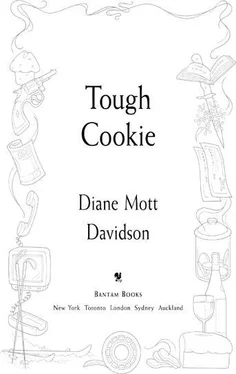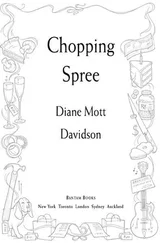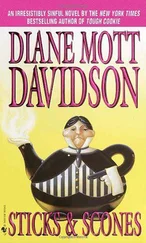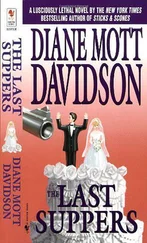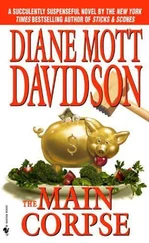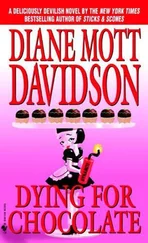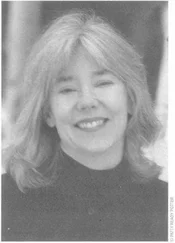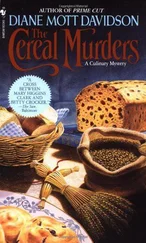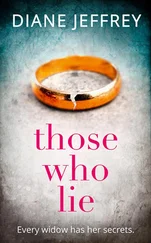“Sounds great.”
“Afterward, we could ski together, if you want.”
I laughed. “Sure. But I’m strictly a slow-going blue-run skier. And I rarely have wine with lunch.”
His puzzled look said Are you joking? But he merely mumbled, “See you at the bistro Wednesday at noon,” grabbed his keys, checked the locked door in the hallway, glanced at the Dresden shepherdess figurine on his front table, and took off.
I studied the three “sample” bottles on the counter. Why did he have a fit when I offered to get out the rest of the wines? As his Escalade roared down the driveway, I began mixing the crab cake ingredients, thinking hard. Arthur probably didn’t want me fetching the wines because wine geeks are notoriously secretive about their cellars. I rolled the crab cakes in crumbs and slid them into the refrigerator next to the strudel, then peeked out the front window. The Escalade was nowhere in sight.
The door in the hallway was indeed locked. I hesitated. If I snooped around, but didn’t steal anything, could I lose my bonding? If I snooped around, and Arthur came back and caught me, would he break a wine bottle over my head? Would it be full or empty?
I won’t steal a thing , I promised myself. If he comes back, I’ll just say I was looking for the wines. To try to help him out, I’ll tell him. What I wouldn’t tell him was that his locked door and furtive ways had me convinced he was trying to hide something besides chardonnay. And that always provokes me to find out if I’m right.
First I checked his leather jacket for the key. His “lost” checkbook was sticking out of one of the pockets. I remembered his visual check of the Dresden shepherdess on the table. I lifted the delicate china piece and found a small brass key beneath it. When I unlocked the door, it opened onto a carpeted staircase.
I tiptoed down, holding my breath, and found myself in a long hallway lined with color photographs. This lower level held two guest rooms, a bathroom, and another closed door. The wine cellar?
Someone desperate for information, valuables, or something had broken into Doug Portman’s apartment the day he died. The sheriff’s department had discovered no evidence linking Portman to alleged under-the-table payments, although they had yet to search through his sealed boxes of military memorabilia. If an uncategorized piece of art or an antique weapon had been within reach of the burglar, it could have been stolen. If there had been files or papers in the condo, they could have been removed. Most significantly, if there had been any immediately recognizable clue as to what Doug Portman was up to, it had vanished. Who needed something belonging to Doug Portman? Needed it badly enough to burglarize a dead man’s home? If you had nineteen million dollars riding on finding evidence of Portman’s wrongdoing, wouldn’t you rush to go through the place? And if you’d killed him, wouldn’t you know you had only a few hours’ jump on the cops?
I gulped. How well did I really know Arthur? He had been friendly when he wasn’t nerve-wracked, which was most of the time. Did I really think he was capable of killing someone? Hard to tell.
I turned the knob on the closed door at the end of the basement hallway. Locked. Did Arthur have the wine-cellar key on him, or was it hidden down here? Where had he kept the key to the basement? In the hallway, under a figurine.
I walked up and down the hall, much the same way I’d strolled past the “Best of Killdeer” show at the art gallery. Here, finally, were the family photographs that one would have expected to see on the upper floor. All had dates underneath. Several of them featured Arthur a decade ago, standing beside a tall, good-looking woman whom I recognized from the articles left for me: Fiona Wakefield. She smiled with her son from the Bridge of Sighs in Venice, from the steps of the Parthenon. There was a picture from the Sixties, taken in front of the Waldorf-Astoria. In this one, Fiona had her arm around a handsome man I assumed to be Arthur’s father.
But one photograph in particular caught my attention. In sunglasses, clad in bright snowgear, Fiona smiled on a snowy mountaintop. There had been someone standing next to her, but that person’s image had been neatly sliced away; all that remained were the tips of another pair of skis. A penned-in date indicated a time four years ago.
The person cut out of the picture had to be Jack Gilkey.
The photograph was mounted in an acrylic frame. Gilkey stole my future , Arthur had told me. I carefully lifted the framed photo off the wall. Something clinked to the floor. I looked down: At my feet was a gleaming key ring. Dangling from the ring were a door-size brass key and a small steel padlock key.
CHAPTER 15
Now that I had the key, the locked door opened easily. Behind it, a padlocked gate barred entry to the cold, gloomy cellar itself. I undid the padlock and removed it, then creaked the gate open.
I groped for a switch; overhead lights blazed through the gloomy space. The walls were made of Colorado river rock. Stacks of crisscross-style bins held hundreds of wine bottles, each lying on its side. My shoes crunched against the stone-paved floor as I moved cautiously forward. The cellar was not a square, it was not even symmetrical: It had angled walls and dark corners. I shivered. How much had it cost Arthur to put in this storage bunker? Worse, through these thick walls, how would I even hear him if he came back?
I quickly scanned the bins for anything besides wine. Ignoring the cold, I crossed to a near wall where a bin contained two file folders. I flipped through the first file: it apparently contained a log of what was stored in the cellar. The second file was stuffed with papers detailing outflow from Arthur’s supply—to whom the wine went, when, and how much. I moved on to a set of shelves built into the rock wall. This held two rows of empty bottles; names and dates were scribbled on each label. The labels were difficult to read, but seemed to be records of when the bottles had been consumed. The man obviously carried wine-obsession to new heights. On the floor were more empty labeled bottles, as if Arthur had run out of room for his souvenirs.
A foot away from the empty-bottle rack, he’d mounted a color poster of limestone cliffs next to a dark blue sea. The poster-photograph looked familiar. I suddenly realized I was looking at the Mediterranean: This was another view of the French village of Bandol.
I keep the picture here to remind me .
The four corners of the poster were affixed to the wall with gummy adhesive. I peeled up the bottom right corner, then the left, and discovered what I’d suspected: behind the poster was a double set of shelves just like the one with the empty bottles. For some reason, Arthur had emptied out these shelves and put the bottles on the floor, to make an impromptu—and hidden—storage area. Why?
Disappointingly, only one shelf contained something: four letters and a UPS package. I was not surprised to see that every single item had been addressed to Doug Portman. Nor was I shocked to note that every one had been slit open and, presumably, read.
I worked my way through the letters first. Their postmarks indicated they’d been mailed in the first two weeks of December. One was from a potential buyer in Minnesota who wrote to say he was interested in unjacketed bullets from the Civil War. Another was from someone wanting to sell Doug a rifle complete with bayonet. The earliest postmarked letter was from Mexico. It was from one Juanita Martinez, and explained in formal English that Señor Portman’s guest villa awaited him. Señor would be able to do business in the town, Puerto Escondido. Spanish for Hidden Port; I knew that much. I also knew Puerto Escondido was not a high-profile American tourist destination.
Читать дальше
